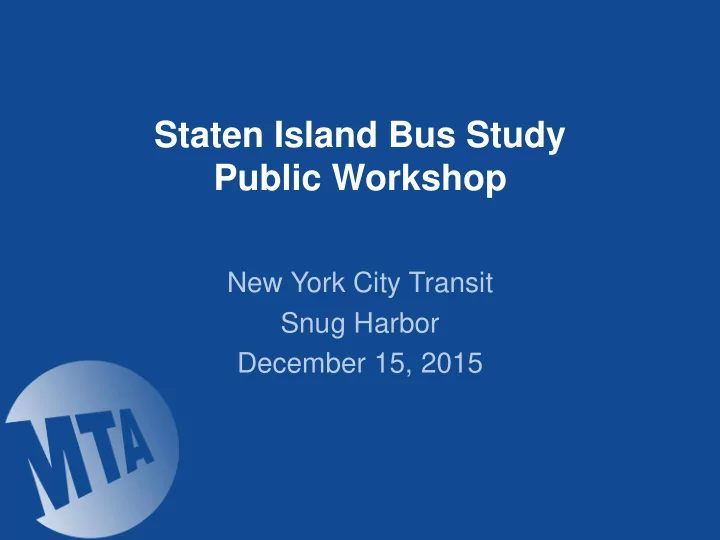

Staten Island Bus Study Public Workshop New York City Transit Snug Harbor December 15, 2015
Quick Facts • 31 local bus lines: 95,000 average weekday customers – Most popular: S79 SBS ( 10,600 average weekday customers) • 20 express bus lines: 34,500 average weekday customers – Most popular: X1 ( 6,200 average weekday customers) • While bus ridership is declining citywide, Staten Island local bus ridership increased 1.2% between 2013 and 2014. Express bus ridership fell 1.5% 1
What We Are Looking At • How have changing demographics, employment centers, and neighborhood characteristics shifted transit needs? • Where are the most significant reliability issues (on-time performance, wait assessment, missed trips, etc.) occurring? • How does spacing between bus stops affect trip speeds and reliability? • What is the impact of Manhattan traffic on express buses? • How do different Friday travel patterns impact bus service? • What are the usage characteristics of official park-and-ride lots and on-street parking to access bus stops? • What internal operational changes can be made to improve efficiency? • Are there opportunities to simplify complex routes and schedule patterns? 2
Information Sources • MetroCard: Provides information on what buses riders are boarding and when • Bus Time and Automated Data: GPS data feeds and other bus data will provide more detailed information on performance and ridership • Observations: Qualitative data and validation of automatically collected data • US Census: Data on demographics, employment, commute patterns, etc. • Public feedback: Survey research (riders and non-riders), workshops, written feedback, and informal outreach 3
Recommendations • Recommendations will respond to specific problems identified • Both short and long-term recommendations will be included • Implementation of recommendations will be dependent on operating budget and vehicle fleet availability 4
Timeline Project kickoff Research and initial analysis Intro meetings with community boards Market research surveys Public outreach Final analysis and recommendations Interim progress report Present initial draft of report Revise report for final draft Publication of study Summer Fall Winter Spring Summer Fall Winter 2015 2016 5
Bus Planning Primer • Longer routes generally have poorer performance • Every stop provides more convenient access to the bus but slows down average speeds and makes travel times more unpredictable • Transfers can be inconvenient but they enable many different destinations to be accessed from many different origins • The easiest areas to operate effective bus service have high population densities with well connected street grid networks • Traffic congestion is one of the biggest factors in bus reliability 6
Group Activities Agenda 1. Meet and greet 2. Identify your travel patterns 3. Getting to the bus 4. Hard to reach destinations 5. Poor performance hot spots 6. Open discussion 7
Have Further Input? Email comments to SIBusStudy@nyct.com Fill in Agency Name on Master 8
Recommend
More recommend